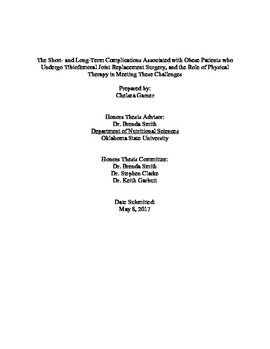| dc.contributor.author | Garner, Chelsea | |
| dc.date.accessioned | 2017-10-10T20:56:56Z | |
| dc.date.available | 2017-10-10T20:56:56Z | |
| dc.date.issued | 2017-05-04 | |
| dc.identifier | oksd_garner_HT_2017 | |
| dc.identifier.uri | https://hdl.handle.net/11244/52313 | |
| dc.description.abstract | Objective: The objective of this research is to examine the complications associated with obese patients who undergo tibiofemoral joint replacement surgery compared to non-obese patients. | |
| dc.description.abstract | Methods: In this research, the pathophysiology of osteoarthritis of the tibiofemoral joint was reviewed, in obese patients compared to patients of normal weight. The incidence of short- and long-term complications following arthroplasty was determined in obese patients compared to patients of normal weight. The success rates of obese patients were compared with patients of normal weight in terms of functionality of the joint and the ability to return to routine physical activity. Lastly, ways in which the recovery after arthroplasty can be improved were examined, and the role of physical therapy in meeting these challenges of obese patients undergoing tibiofemoral joint replacement surgery was discussed. | |
| dc.description.abstract | Results: The degradation of articular cartilage that leads to osteoarthritis progresses at a faster rate in obese patients than in non-obese patients due to increased mechanical load, decreased muscle strength, altered joint mechanics, decreased structural integrity, and mechanoreceptor activation. Following arthroplasty, obese patients at a greater risk for short-term complications, including mortality, longer operative times, infection, and continued drainage. These patients are also at an increased risk of long-term complications, including increased pain and stiffness, unmet physical therapy range of motion goals, and the need for a revision. Obese patients are less likely to return to functionality following arthroplasty than non-obese patients. The physical therapist plays several roles in this process, including pre-arthroplasty muscle strengthening, post-arthroplasty rehabilitation, and post-revision rehabilitation. The therapist may face several challenges when treating obese patients due to the patient's inability to walk long distances, increased weight of their limbs, excess amounts of subcutaneous fat around their joints, and increased risk for co-morbidities. | |
| dc.description.abstract | Conclusions: Obese patients face a greater incidence of short- and long-term complications after undergoing total knee arthroplasty. These patients present unique challenges to physical therapists during rehabilitation of the joint. While obese patients are at a disadvantage both pre- and post-operatively, the physical therapist is uniquely positioned to help combat these challenges and restore function to the joint. | |
| dc.format | application/pdf | |
| dc.language | en_US | |
| dc.rights | Copyright is held by the author who has granted the Oklahoma State University Library the non-exclusive right to share this material in its institutional repository. Contact Digital Library Services at lib-dls@okstate.edu or 405-744-9161 for the permission policy on the use, reproduction or distribution of this material. | |
| dc.title | Short- and long-term complications associated with obese patients who undergo tibiofemoral joint replacement surgery, and the role of physical therapy in meeting these challenges | |
| osu.filename | oksd_garner_HT_2017.pdf | |
| osu.accesstype | Open Access | |
| dc.type.genre | Honors Thesis | |
| dc.type.material | Text | |
| dc.contributor.director | Smith, Brenda | |
| dc.contributor.facultyreader | Clarke, Stephen | |
| thesis.degree.discipline | Nutritional Sciences | |
| thesis.degree.grantor | Oklahoma State University | |
